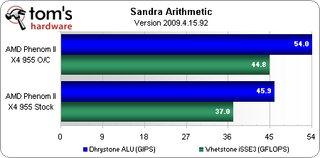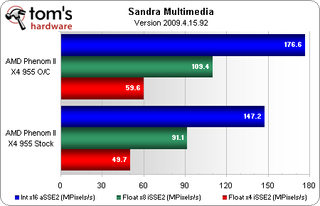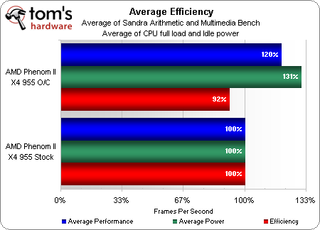Guide: Overclocking AMD And Intel CPUs On A Budget
Phenom II X4 955 O/C Performance And Efficiency
| AMD Phenom II X4 Test Settings | ||
|---|---|---|
| Default Settings | Overclock Settings | |
| CPU | AMD Phenom II X4 955 3.2 GHz 2MB L2+6MB L3 Cache, 1.328V | 3.86 GHz, (19x 203 MHz), 1.45V |
| RAM | DDR3-1333 CAS 9-9-9-24, 1.50V | DDR3-1624 CAS 6-6-5-18, 1.65V |
| Motherboard | MSI 790FX-GD70 Socket AM3, 790FX/SB750, BIOS 1.3 (04/27/2009) | |
| Graphics | Zotac GeForce GTX260² 576MHz GPU, 999 MHz Shader, 896MB GDDR3-2484 | |
| Hard Drive | Western Digital VelociRaptor WD30000HLFS 300 MB, 10,000 RPM, 16 MB Cache | |
| Sound | Integrated HD Audio | |
| Networking | Integrated Gigabit LAN | |
| Software | ||
| Operating System | Microsoft Windows Vista Ultimate x64 SP1 | |
| Graphics | GeForce 182.08 Desktop |
The X4 955’s 21% overclock probably isn't going to bowl anyone over, but its 3.86 GHz final speed is still well above average for an air-cooled Phenom II system, thanks to the good performance of Rosewill’s Fort 120 cooler.


Sandra shows a 19% improvement in Arithmetic and 20% improvement in Multimedia extensions performance.

Though memory data rate and timings were altered significantly, its performance improved by only 1%. The X4 955 has better base bandwidth than the X2, but apparently less room for improvement.

Power consumption increased by 31%, mostly because of the higher voltage required to reach this high clock speed.

An average CPU performance increase of 20% and an average power increase of 31% caused the overclocked Phenom II X4 to lose around 8% of its original efficiency. Once again, it would likely have been possible to actually increase efficiency by overclocking at or near stock voltage, but the maximum speed increase would have been much smaller. For more on increasing the efficiency of your Phenom II overclock, check out this piece.
Stay on the Cutting Edge
Join the experts who read Tom's Hardware for the inside track on enthusiast PC tech news — and have for over 25 years. We'll send breaking news and in-depth reviews of CPUs, GPUs, AI, maker hardware and more straight to your inbox.
Current page: Phenom II X4 955 O/C Performance And Efficiency
Prev Page Overclocking AMD's Phenom II X4 955 Next Page Overclocking Intel's Pentium E5200-
tacoslave i like these "how to" articles but i still want to see the rest of the twkr article you promised us (quad crossfire 4890's) *sigh* a man can dream can't he?Reply -
snakeeater_za Surely people on a budget (like me) would prefer their e5200 to last longer than a 'few months or hopefully a yr to 3?' i know i will upgrade prob in a year or so, so a yr would be fine, but a few months? Pfffft. my proc vid is 1.225 and for 3.33ghz i need a vcore of 1.385 in bios which at idle is 1.36ish. So although im nowhere near 4 at least i wont suffer from electromigration and have to fork out for a new cpu! Just my 2 centsReply -
Crashman snakeeater_zaSurely people on a budget (like me) would prefer their e5200 to last longer than a 'few months or hopefully a yr to 3?' i know i will upgrade prob in a year or so, so a yr would be fine, but a few months? Pfffft. my proc vid is 1.225 and for 3.33ghz i need a vcore of 1.385 in bios which at idle is 1.36ish. So although im nowhere near 4 at least i wont suffer from electromigration and have to fork out for a new cpu! Just my 2 centsReply
It's all a game of averages. Tom's Hardware hasn't accidently killed a processor by overclocking it in a while, though I'm sure a couple editors have intentionally done so to find the voltage limit. The problem is, once again, you can only look at averages.
3 months continuous use at 1.45 volts caused an E8500 to lose its OC stability. It had to be clocked down to become stable again, and lost much of its voltage tolerance. It wasn't destroyed however.
1.40 volts should be significantly safer than 1.45 volts, but until a few people report on how long their cores lasted at 1.40 volts its impossible to tell "how much safer", that is, how much longer it will last. All that's known is that it should last "significantly" longer, but whether that's 4 months (33% longer) or 30 months (10x longer) is the unanswerable question. -
astrodudepsu Good show mate.Reply
I would have liked to see combined charts as a conclusion but that's a minor criticism.
I'm just wondering what the 'next-gen' E5200 (i.e. the intel people's OC'er) will turn out to be? Some flavor of i5 I assume, but who knows. -
JeanLuc LinkReply
"Intel’s value-priced Core 2 Quad Q8200 uses two of the same processor dice as the Pentium E5200....."
I don't know why you choose the Q8200 it's a notoriously bad overclocking chip, if you wanted a budget Intel Quad core that had room for overclocking you should have bought the Q6700/Q6600. -
”Motherboard MSI P45 Diamond LGA-1366, P45/ICH10R, BIOS 1.5 (10/10/2009)”Reply
MSI P45 Diamond is not LGA1366, but LGA775. LGA1366 is for Core i7 processors only, LGA1156 is for Core i5 and i7 (only dual channel DDR3-1333/1066). LGA775 is the old socket, for Celeron D, Celeron 4xx, Pentium Dual Core, Pentium 4, Core 2 Duo, Core 2 Quad. -
da bahstid No games? Like...none at all? Does anybody even overclock for reasons other than games?Reply
Otherwise, pretty good article. Though perhaps a better choice for the Intel quad would have been a 9550...I thought they were under $250 by now. Same time, I guess the Q8200 does seem to be a more difficult overclocker...Intel may have intended this to be the case so as not to gut sales of their Q9000 series. And readers may as well know before jumping on a Q8200 thinking it'll overclock like an E5200.
Most Popular


